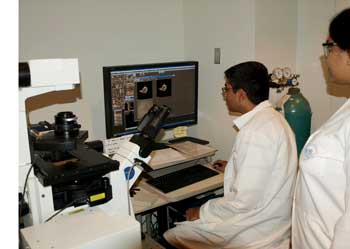
 |
|
We are interested in the biological consequences of PDT at both the cellular and molecular level. Due to the high complexity of carcinomas and their ability to induce survival pathways and become resistant to chemotherapeutics, our lab is developing mechanism-based PDT combination treatments in which one treatment will nullify the tumor survival responses resulting from the other treatment. The strategies involve either sequential administration of combination therapies or using nanoconstructs with multiple agents for:
Combining PDT with Anti-Angiogenesis Agents
Vascular endothelium growth factor (VEGF) is a potent stimulant of new vascular growth and is an important factor in tumor growth. VEGF induction following sub-curative PDT can provide a stimulus to tumors and reduce the efficiency of this treatment. Our group is currently studying treatments that inhibit the effects of VEGF for use in combination with PDT of both prostate and pancreatic cancers. We have found that VEGF-blocking agents reduce PDT-associated metastases to distant organs. Furthermore, we are developing VEGF contrast agents to monitor the increase in VEGF expression following PDT (see Optical Imaging for PDT Development). The ability to track VEGF expression following PDT gives us the opportunity to calculate precisely the dose of the VEGF counter-therapy, which will provide a patient-specific treatment to reduce possible side effects.
Combining PDT with Cell-Differentiating Agents
ALA-PDT is an increasingly accepted treatment for skin cancers. One problem of ALA-PDT is its lack of tissue penetration, which can lead to a sub-curative PDT dose in deeper tissues, triggering cell survival responses that can affect the treatment outcome. Our lab has previously discovered that differentiating agents, such as Vitamin D, can increase photosensitizer levels after ALA administration, thereby enhancing the overall effect of ALA-PDT. In an orthotopic prostate tumor model, we found that methotrexate, a commonly prescribed differentiating agent, can nullify the increase in metastases associated with PDT. In collaboration with Dr. Edward Maytin at the Learner Research Institute in Cleveland, we are investigating the mechanisms behind PDT enhancement by differentiating agents and exploring the use of new compounds that can enhance PDT of skin tumors.
GFR as a Molecular Target for PDT
GFR for example, epidermal growth factor receptor (EGFR), over-expression is associated with the development of chemotherapeutic-resistant ovarian and other cancers. Although EGFR inhibition is an effective treatment modality for cancer, resistance to such agents is a serious problem. We have demonstrated that PDT combined with an immunotherapy that targets EGFR produces a synergistic reduction in tumor burden. Furthermore, in our animal studies, this mechanistically non-overlapping combination modality increased survival rates in orthotopic ovarian tumor models. This overall approach is being studied for other cancers, including pancreatic, prostate, brain, and head and neck cancers. GFRs of current interest include EGFR, VEGFR, IGFR, and cMET.
Projects
- Site-Directed PDT
- Mechanism-Based Combination Therapies
- Image-Guided Therapeutics
- Disease Model Development













